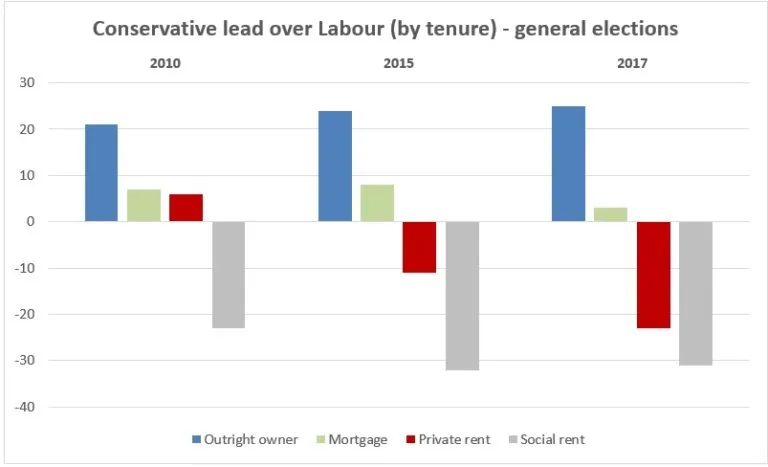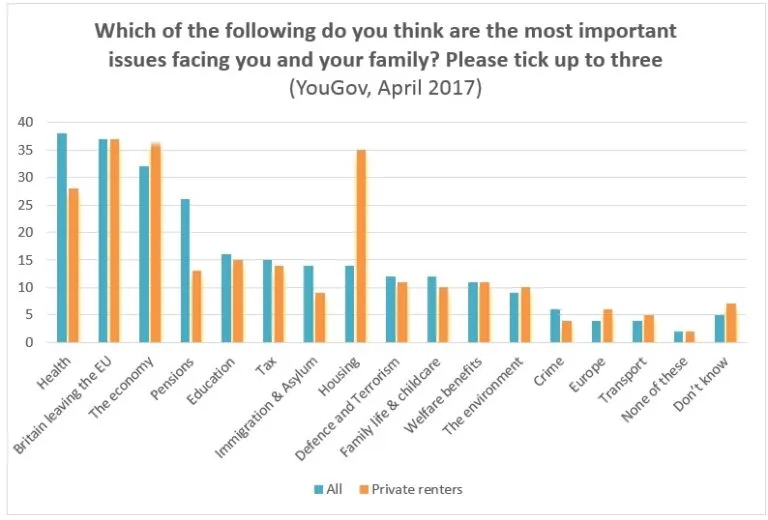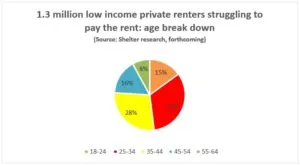Housing and the 2017 election: what the numbers say
Published: by Steve Akehurst
As the dust settles on the general elections results, attention has turned to trying to understand some of the demographic trends behind the results.
At Shelter, we’ve long had our eye on trends in housing tenure and how these might shape political outcomes. For context, mortgaged home ownership in England has fallen from 42% to 29% since 2000, while private renting has doubled in that time (to 20%).
We will publish more data as it becomes available in the coming weeks, but here’s what we can piece together so far:
1. Private renters swung to Labour, home owners stuck with the Conservatives
New Ipsos data out yesterday shows, in glorious detail, breakdown by demographic.
 Labour narrowed the gap with the Conservatives among mortgaged home owners slightly, while the Conservative lead among outright homeowners (people who have paid off their mortgage or cash buyers) remains similar.
Labour narrowed the gap with the Conservatives among mortgaged home owners slightly, while the Conservative lead among outright homeowners (people who have paid off their mortgage or cash buyers) remains similar.

By the same token, social renters opting for Labour in big numbers is nothing new, and their lead remains roughly the same.
But what’s noticeable is the massive swing to Labour among private renters this time around – up from a lead of 11 points to a lead of 23 points.
Turnout among private renters is still less than home owners, but it jumped by 8% – more than any other tenure – to 53%.
2. The impact of private renters was felt in key marginals
This nature of this swing in private renters towards Labour was felt in English marginals.
Both the raw number and overall proportions of private renters are strongly correlated with falls in the Conservative vote. The number of private renters in an area correlates even more strongly than age to a fall in the Conservative vote.
An important point to make here is it’s often not just private renters who see their political attitudes shaped by housing – but also their older, more secure home owning parents worried about their children’s future, or seeing their communities impacted by an explosion in Buy-to-Let housing or HMOs.

 3. Private renters care about housing more
3. Private renters care about housing more
Of course, correlation is not causation. It could be argued that this is just a by-product of the fact private renters can tend to be under-45 or live in more urban areas. However, private renters also consistently say they care about housing more – as they deal with the high rents, instability and poor conditions private renting often brings. For the public, housing tends to be a top 5 or 6 issue – but for private renters it’s a top 3 issue, on a par with Brexit and the economy. We also know it’s one of the few issues Labour had a lead on among voters.
It feels reasonable to say, then, that housing is at least one important driver of the block of voters which switched heavily to Labour in this election.
 4. The Conservatives found it particularly tough in marginals with low income private renters – a growing group
4. The Conservatives found it particularly tough in marginals with low income private renters – a growing group
Indeed, the Conservatives seem to have found it hardest in marginal seats where low income private renters live – those most directly hit by the crisis.
We estimate there are around 1.3 million hard pressed private renting households in England – those who fall beneath minimum income standard after paying the rent. As we argued in the election, these renters vote and often have the consumer habits of typical swing voters.
YouGov suggests there are 52 English marginals where this group of harder pressed private renters are disproportionately represented. The Conservatives lost eight of these seats they held, and made no gains in any of them held by Labour – all of their gains were in seats where low income private renters were under-represented.
This wasn’t just a factor in Remain voting marginals, but Leave ones too. Marginals where low income renters were especially heavily represented include Hastings and Rye, where the Home Secretary just held on, and seats Labour gained such as Crewe and Nantwich, Croydon Central, Bedford, Plymouth Sutton and Davenport, High Peak and Colne Valley.
Our research on this area, which we’ll publish in the autumn, also shows that two groups which swung heavily to Labour – 25-34s and 35-44 year olds – make up the largest chunks of low income private renter group.
 5. So what does all this mean?
5. So what does all this mean?
Clearly, this election was more than just housing. But on this evidence we can say housing – and the impact of the housing crisis on private renters – is one of the key factors that helped polarise results on June 8th,.
In some ways this is not surprising. Housing continues to be a key driver of inequality and, in some cases, hardship – as the shortage of homes, especially affordable homes, spreads to all corners of the country and impacts more people.
It’s not simply that home owners have an ‘asset’, but that their home provides them a stability and, comparatively at least, affordability that private renters do not currently enjoy. For instance, renters pay 41% of their take home salary in rent; home owners pay 21% of their salary towards their mortgage. Home owners can stay in their home for life if they meet their mortgage payments; renters have six month contracts as standard.
The best response the new government can have to this is not to resile from the challenge in the face of tougher political circumstances, but to double down on efforts to fix things. It can be done.
Indeed, the irony is that a lot of what was in the Conservative manifesto was promising in this regard, and the people who put it together understood what needed to be done. Their promise to ban unfair letting fees for tenants, for instance, could save private renters an average of £350 each time they move; it has to be followed through on. Noises around introducing more security in the private rented sector were also positive – we’ve campaigned for introducing legislation to make 5 year tenancies, with rents linked to inflation, the new norm.
But fundamentally, this is about building more good quality homes that people can afford and can put down roots in, to bring prices and rents back within the reach of ordinary people. The Conservative manifesto promise to strengthen Compulsory Purchase Orders (CPO) is a key part to reshaping the private housebuilding market to achieve this, as our New Civic Housebuilding project made clear.
Beyond all this, we have called for a new generation of affordable homes at ‘living rents’ – to help the growing group of low income private renters falling through the middle of our housing market: not well off enough to afford home ownership or government schemes like shared ownership, but not in acute enough need to access social housing. This would provide stability and affordability that private renting does not, and could be combined with a ‘right to buy’ after a certain number of years.
Either way, the 2017 election was arguably the moment where the power of Generation Rent was felt for the first time. Without significant action to get to grips with our housing crisis, it’s unlikely to be the last.
(This blog is cross posted on City Metric)